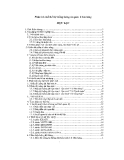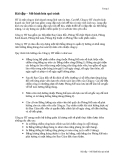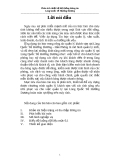
Multi-source Data Analysis for Bike Sharing
Systems
Nguyen Thi Hoai Thu, Le Trung Thanh, Chu Thi Phuong Dung, Nguyen Linh-Trung, Ha Vu Le
University of Engineering and Technology, Vietnam National University, E3, 144 Xuan Thuy, Cau Giay, Hanoi, Vietnam
Abstract—Bike sharing systems (BSSs) have become common
in many cities worldwide, providing a new transportation mode
for residents’ commutes. However, the management of these sys-
tems gives rise to many problems. As the bike pick-up demands
at different places are unbalanced at times, the systems have
to be rebalanced frequently. Rebalancing the bike availability
effectively, however, is very challenging as it demands accurate
prediction for inventory target level determination. In this work,
we propose two types of regression models using multi-source
data to predict the hourly bike pick-up demand at cluster level:
Similarity Weighted K-Nearest-Neighbor (SWK) based regression
and Artificial Neural Network (ANN). SWK-based regression
models learn the weights of several meteorological factors and/or
taxi usage and use the correlation between consecutive time slots
to predict the bike pick-up demand. The ANN is trained by
using historical trip records of BSS, meteorological data, and
taxi trip records. Our proposed methods are tested with real
data from a New York City BSS: Citi Bike NYC. Performance
comparison between SWK-based and ANN-based methods is
provided. Experimental results indicate the high accuracy of
ANN-based prediction for bike pick-up demand using multi-
source data.
Index Terms—bike sharing system, regression model.
I. INTRODUCTION
Bike sharing is a service which provides available bikes
as a shared use for individuals on a short-term basis, either
free or at a reasonable price. A bike sharing system (BSS)
allows users to rent a bike from one station and return it at any
other station within the system. BSSs have been deployed in
various cities around the world since the second half of 20th
century and become more popular in recent years [1], [2].
These systems provide access to bicycles for short-distance
trips as an alternative to private vehicles or motorized public
transport such as bus or subway in an urban area. In addition,
they help reduce the traffic congestion, air pollution and noise.
Moreover, they have been considered as a way to solve the
“last mile” problem [3]. Finally, they help bridge the gap
between existing transportation modes such as subways and
bus systems [4] and connect users to public transit networks.
Beside the benefits mentioned above, BSSs face many
problems, one of which is the availability imbalance. Due to
the fact that movements of customers are highly dynamic [5],
the bike usage is non-stationary, changing markedly with time
and location [6]. Therefore, some stations may be short of
available bikes for rent while some are full and do not have
enough docks for returned bikes. A general approach to solve
this problem is that the system should monitor and redistribute
bikes between stations frequently using trucks or bike-trailers.
Real-time monitoring and redistribution, however, take too
much time to execute, especially during rush hours, and
therefore become unrealistic. It is desirable to make accurate
prediction of the pick-up/drop-off demand and inventory level
at each station. To address this issue, a solution must consist of
two main stages: (i) bike pick-up/drop-off demand prediction,
and (ii) rebalancing route optimization. Our work presented in
this paper focuses only on the bike pick-up demand prediction.
We can predict the number of bikes that will be picked up
at each station in the near future, based on the historical
trip records as well as meteorological data. However, apart
from meteorological data, the bike traffic can be influenced by
many other factors, such as time of day, day of week, events,
demographic factors, and the correlation between stations.
They make the problem become more challenging.
There have been a number of studies on bike demand
prediction. Some methods are based on historical demand [7]
or stochastic process [8], [9]. As we mentioned above, the
bike pick-up demand is influenced by many factors. Thus,
exploitation of multiple sources of data affecting BSSs is
highly beneficial to improving bike demand prediction ac-
curacy. It can be considered as a promising approach and
attracts many studies. For instance, Liu et al. [4] proposed
a Meteorological Similarity Weighted K-Nearest Neighbor
(MSWK) model that combines meteorological data and the
past bike demand to predict the hourly bike demand at the
station level. Li et al. [6] first chose to cluster bike stations into
groups using a bipartite clustering algorithm, and then used
meteorological data with a multi-similarity-based inference
model to predict the bike demand at the cluster level. Singhvi
[10] applied a log-log regression model using taxi usage
and spatial variables considered as covariates to predict bike
demand at the neighborhood level.
Inspired by the above multi-source data approach, in this
paper we propose two regression models for predicting hourly
bike pick-up demand at the cluster level instead of the station
level, namely the Similarity Weighted K-Nearest-Neighbor
(SWK) regression model with the correlation among consec-
utive time slots (SWKcor), and the Artificial Neural Network
(ANN) based model. Data utilized by these models in our work
include historical trip records of the BSS, meteorological data,
and taxi trip records. To our best knowledge, there have not
been any studies combining these data sources in analyzing
the BSS demand problem.
This paper is organized as follows. Section II provides
background of the study, including some preliminaries, a
2017 International Conference on Advanced Technologies for Communications
978-1-5386-2896-6/17/$31.00 ©2017 IEEE 235

clustering algorithm, the original MSWK regression model,
and a brief introduction to ANN. Section III introduces our
proposed method to improve the accuracy of bike pick-up
demand prediction. Section IV shows the experimental results.
Section V concludes the work with some notes about future
directions.
II. BACKGROUND
A. Preliminaries
In this section, we introduce some preliminaries, which will
be used throughout this work. Let G={S,E} be a directed
graph representing a system (network) of bike stations. Each
bike station s∈Sis called a node or a vertex, while the edge
ei,j ∈ E represents a directed path from node sito node sj.
Each node or edge has several attributes.
The BSS is constructed by tracking a set of trip records. A
trip record tr = (s0, sd, τ0, τd)is a bike usage record of a trip
from an origin station s0to a destination station sd, and τ0
and τdare the pick-up time and the drop-off time, respectively.
Only trips with duration (τd−τ0) larger than one minute are
recorded. Each day is separated into 24 time slots of one hour
duration, t∈ {0,1,...,23}.
Definition 1 (Station bike demand): Let si(Dt)denote the
pick-up demand of station siduring time slot tof day D.
Definition 2 (Cluster bike demand): Let ci(Dt)denote the
total pick-up demand of stations in cluster ciduring time slot
tof day D.
B. Bipartite clustering
A number of recent studies have used clustering algorithms
for bike pick-up demand prediction. There are two reasons
why we need to predict bike pick-up demand at the cluster
level instead of the station level. First, because the bike pickup
demand is affected by multiple factors, such as the weather
and the correlation between stations, traffic of a single station
seems too chaotic to predict [6]. Thus, clustering makes the
prediction easier. Second, it is not necessary to predict the
pick-up demand of each individual station because people
often pick the bikes up at a random station near their place.
Therefore, for bike reallocation, knowing the pick-up demand
of each cluster is sufficient. In fact, most of existing BSSs have
a real-time status map which shows the number of available
bikes and docks. If a station is empty or full of bikes, it is
convenient for a user to find another nearby station. Besides,
if there is some event happening which influences bike usage,
it is common that the bike traffic of an area encompassing
several stations will be affected.
We employ a clustering algorithm, proposed by Li et al. in
[6], to group individual stations into clusters based on their
geographical locations and transition patterns. It generates a
set of matrices, each is called a t-matrix which describes the
transition pattern of a station. Each entry of a t-matrix, (Ai)l,j ,
is the probability that a bike will be dropped off at cluster C1,j
given that it was picked up from station si. The pseudo-code
of this algorithm is described in Alg. 1.
Algorithm 1 Bipartite clustering algorithm
Input: Stations {si}n
i=1, historical trips {tri}n
i=1; iteration
threshold K, parameters K2< K1;
Output:K1clusters: C1,1, C1,2, ..., C1,K1
1: Cluster {si}n
i=1 into K1clusters: C1,1, C1,2, ..., C1,K1by
K-mean based on locations
2: Initialization:
3: k←0
4: Recursion:
5: While k < K
6: For i= 1 to ndo
7: Generate matrix {Ai}n
i=1 of station {si}n
i=1.
8: Matrix Aiis the probability that a bike will be
checked into cluster {Cj}k
j=1.
9: P(Ai→Cj) = T rips(Ai→Cj)
T rips(Ai→ {Cl}k
l=1)
10: Cluster {si}n
i=1 into K2clusters: C2,1, C2,2, ..., C2,K2
by K-mean based on {Ai}n
i=1
11: For j= 1 to K2do
12: Cluster stations in C2,j into NjK2
nclusters with
Njare numbers stations of C2,j
13: Obtain K1updated clusters
14: If C1,1, C1,2, ..., C1,K1do not change Then
15: Break;
16: k←k+ 1;
17: Return K1clusters C1,1, C1,2, ..., C1,K1
Weather
Reports
Weather
condition
segmentation
Similarity
measurement
MSWK
parameter
learning
Bike pick-up
demand
prediction
Fig. 1. Structure of original MSWK model.
C. Meteorological SWK regression model (MSWK)
We inherit a recently proposed MSWK regression model
in [4] which predicts the station level pick-up demand and
introduces some new methods making use of clustering and
correlation between time slots to improve its performance.
A regressor is built to predict si(Dt
q), the station level
bike pick-up demand during time slot tof day Dqbased on
the demand during same time slot tof previous days and a
meteorological multi-similarity function. The structure of this
regression model is shown in Fig.1.
1) Weather condition segmentation: The weather report
RDt
pcontains the weather condition WDt
p(sunny/raining/etc.),
temperature FDt
p, wind speed SDt
p, and visibility VDt
pof
time slot ton day Dp. In this step, weather conditions
are divided into four groups according to their suitabil-
ity for outdoor cycling: G1={sunny,cloudy};G2=
{fog, mist, haze};G3={snow, rain, light snow, light rain};
G4={heavy snow, heavy rain}.
Fig. 2 shows the effect of meteorological factors on bike
usage in Citi Bike NYC. The bike pick-up demand is sensitive
to temperature: the demand tends to decrease when the tem-
2017 International Conference on Advanced Technologies for Communications
236

012345
Precipitation (inch)
0
2
4
6
Number of trips
104
0 2 4 6 8 10 12
Snow fall (inch)
0
2
4
6
Number of trips
104
0 20 40 60 80 100
Temperature ( °F)
0
2
4
6
Number of trips
104
0 5 10 15
Wind speed (mile/h)
0
2
4
6
Number of trips
104
20 40 60 80 100
Humidity (%)
0
2
4
6
Number of trips
104
0246810
Visibility (mile)
0
2
4
6
Number of trips
104
Fig. 2. The effect of meteorological factors on bike usage in Citi Bike NYC.
perature is too low (under 50oF) or too high (over 85oF). The
wind speed and visibility show strong correlation in affecting
the bike demand: the demand decreases with higher wind
speed/lower visibility, and vice versa. The humidity seems to
have no significant impact on bike usage.
2) Similarity measurement: The meteorological similarity
between two different days, Dt
pand Dt
q, are calculated by
using a linear combination of three units: weather condition
similarity, temperature similarity, and wind-speed-visibility
similarity. Each unit is associated with a weighted coefficient
that is learned to improve the accuracy.
Weather similarity At first, we manually segment the
weather conditions into different levels according to their
effects on bike pick-up demand. Let (G1, G2, G3, G4)= (0.25,
0.5, 0.75, 1), the weather condition similarity is defined as:
λ1(WDt
p, WDt
q) = 1
2πσ1
exp(−WDt
p−WDt
q2
σ2
1)(1)
Temperature similarity:
λ2(FDt
p, FDt
q) = 1
2πσ2
exp(−FDt
p−FDt
q2
σ2
2)(2)
Wind-speed-visibility similarity:
λ3=1
2πσ exp(−(SDt
p
−SDt
q)2
σ2
3
+(VDt
p
−V SDt
q)2
σ2
4)(3)
Similarity function Before calculating similarity measures,
we normalize the temperature, wind speed, and visibility
values into range [0, 1] and set σk= 1 (k= 1,2,3,4)
to simplify the equations (1)-(3). The similarity function is
defined by the following linear combination:
M(Dt
p, Dt
q;a) =
3
X
i=1
aiλi(4)
3) Bike pick-up demand prediction: Given predefined val-
ues of Hand a, we select the top Hdays {Dt
1, Dt
2, ..., Dt
H}
having the highest similarity scores, calculated by the similar-
ity function, to our target day Dt
q. Then si(Dt
q)is predicted
by a similarity-weighted KNN:
si(Dt
q;a) = PH
p=1 M(Dt
p, Dt
q;a)∗si(Dt
p)
PH
p=1 M(Dt
p, Dt
q;a)(5)
4) MSWK parameter learning: The weight of a given
meteorological similarity ain equation (5) is obtained via a
training process such that the minimum prediction absolute
error of predicted value ˆsi(Dt
q;a)against the ground truth
si(Dt
q)is reached by brute force searching:
minimize
a
1
N
N
X
i−1
|ˆsi(Dt
q;a)−si(Dt
q;a)|(6)
D. Artificial neural networks
Artificial neural networks (ANNs) are a bio-inspired learn-
ing models aimed at simulating the behavior of biological
neural networks [11]. ANNs are indeed connectionist systems
which are composed of a number of interconnected artificial
neurons. They are typically organized into layers. Objects
are presented to an ANN through the input layer, which
communicates with one or more hidden layers via weighted
connections. The hidden layers connect to the output layer in
the same manner. As an useful analytical tool, ANN is widely
used to solve prediction problems in various research fields.
III. METHODS
A. SWK based models
We improve the MSWK model proposed in [4] by i) using
the bipartite clustering algorithm in [6], then predicting the
pick-up demand based on the correlation between consecutive
time slots, ii) using SWKcor with the meteorological similarity
measure (MSWKcor), and iii) using SWKcor with a taxi usage
similarity measure (TSWKcor). Our proposed modification
is motivated by the observation that, when the system is
expanded, the demand increases significantly, or if there is
an event happening in the target day or the previous days,
2017 International Conference on Advanced Technologies for Communications
237

Weather report
Weather
condition
segmentation
Similarity
measurement
Trip records
Station
clustering
Calculate
correlation
between time
slots
MSWK
parameter
learning
Bike pick-
up demand
prediction
Station map
Fig. 3. Structure of the MSWKcor regression model.
the demand at the same time slot of the target day is highly
different from past days. Because the bike pick-up demand of
one cluster is supposedly a time series, the demand at time
slot tmay relate to the demands at previous time slots. We
calculate the covariances Covi(t, t −1) and Covi(t, t −2)
between pick-up demand of cluster ciat time slot twith time
slots t−1and t−2, respectively.
1) SWKcor with meteorological data (MSWKcor): The
structure of the modified MSWKcor model is shown in Fig. 3.
After calculating the similarity by (4), given Hand a, we
can select the top Hdays D={Dt
1, Dt
2, , Dt
H}having the
highest meteorological similarity scores to our target day Dt
q.
With each Dt
p∈D, we obtain the coefficient xi(Dt
p)by the
following formula:
ci(Dt
p) = Covi(t, t −1)ci(Dt−1
p) + Covi(t, t −2)ci(Dt−2
p)
xi(Dt
p).(7)
With each xi(Dt
p), we estimate ˆci(Dt
q, p)
ˆci(Dt
q, p) = Covi(t, t −1)ci(Dt−1
q) + Covi(t, t −2)ci(Dt−2
q)
xi(Dt
p).
(8)
Then ci(Dt
p)is predicted by a similarity-weighted KNN by
ˆci(Dt
q;a) = PH
p=1 M(Dt
p, Dt
q;a)ˆci(Dt
q, p)
PH
p=1 M(Dt
p, Dt
q;a).(9)
2) SWKcor with taxi usage data (TSWKcor): Bike and taxi
are two types of transportation which are very popular and
convenient in cities. The bike pick-up demand of BSS and the
number of taxi trips seem to have no relationship when one
is a simple vehicle with low speed and the other is a motor
vehicle with high speed. However, they do have something
in common, for example, most of the bike trips and taxi
trips travel short distances, between 0.5 miles and 10 miles
(98% bike trips and 95% taxi trip in NYC). Besides, users
(passengers) may switch from taxi to bike when there is a
traffic jam, or switch from bike to taxi when it rains or when
it is too cold. Therefore, taxi usage data may give hints to
predict the bike pick-up demand. In order to realize that idea,
we first collect data about taxi trips picked up in the bike
cluster, which have the properties suitable for bike trips.
The structure of the TSWKcor model is similar to the
MSWKcor model, it uses taxi usage data for similarity mea-
surement instead of meteorological data. In this model, to
predict the demand ci(Dt
q)of cluster ciat time slot tof day Dq
, we measure the similarity of taxi usage between two different
days Dqand Dp. Given taxi usage data of two previous time
slots (t−1) and (t−2) of day Dqat cluster ci, denoted
Ti(Dt−1
q)and Ti(Dt−2
q)respectively, the similarity scores are
calculated as follows:
λ1=1
2πσ1
exp(−(Ti(Dt−1
p)−Ti(Dt−1
q)
σ12).(10)
λ2=1
2πσ2
exp(−(Ti(Dt−2
p)−Ti(Dt−2
q)
σ22).(11)
The taxi usage similarity are also calculated by using the
following linear combination:
M(Dt
p, Dt
q;i;a) =
2
X
j=1
ajλj(12)
After finding the top Hdays having the highest taxi usage
similarity scores, the TSWK parameter learning step and the
bike pick-up demand prediction step of the TSWKcor model
will be carried out in a similar manner to the MSWKcor
model.
B. ANNs
Four ANNs are used for four datasets: 1) BSS data, 2) BSS
data with meteorological data, 3) BSS data with taxi usage
data, and 4) BSS data with meteorological and taxi usage data.
1) ANN for BSS data: Because the bike pick-up demand
varies from cluster to cluster, time slot to time slot, and day to
day; and the demands at previous time slots also influence the
target time slot; our proposed ANN for the BSS data uses the
following features as inputs: time of day (time slot), day of
week, cluster ID, and the pick-up demands of previous time
slots.
2) ANN for BSS data with meteorological data: In addition
to the features used by the first ANN, the following meteo-
rological factors also used by this ANN: weather condition,
temperature, wind speed, and visibility.
3) ANN for BSS data with taxi usage data: In addition to
the features used by the first ANN, inputs to this ANN also
include taxi usage data of the previous time slots.
4) ANN for BSS data with meteorological and taxi usage
data: This ANN’s inputs include all features used by the first
three ANNs, as listed in Table I.
IV. EXPERIMENTAL RESULTS
A. Experimental data
We conduct our experiments on bike trip history data, taxi
usage data, and meteorological data from NYC, focusing on
rush hours (from 7 am to 22 pm) on workdays, from July 1st,
2013 to June 30th, 2014. The dataset is divided into a training
set (July 1st - April 30th) and a testing set (May 1st - June
30th).
1) Citi Bike Data: Citi Bike transactions are generated by
NYC BSS which is publicly available from Citi Bike official
website. This data set contains the following information: sta-
tion id, bicycle pick-up station, bicycle pick-up time, bicycle
drop-off station and bicycle drop-off time.
2017 International Conference on Advanced Technologies for Communications
238

TABLE I
FEATURES OF BBS, METEOROLOGICAL,AND TAXI USAGE DATA.
Data Feature
Time Time of day (Time slot)
Day of week
Location Cluster ID
Bike trip records Bike demand of previous time slots
Meteorology Weather condition
Temperature
Wind speed
Visibility
Taxi Taxi usage of previous time slots
2) Taxi Data: The taxi usage data used in this work are for
the Yellow Taxi service and made public on the website of
NYC Taxi and Limousine Commission (TLC). The Yellow
Taxi is one of the main taxi service of New York which
can pick up passengers anywhere in New York City. The trip
records include: pick-up and drop-off times, pick-up and drop-
off locations, trip distances, itemized fares, rate types, payment
types, and driver-reported passenger counts.
3) Hourly Weather Report: The NYC weather report data
contains the hourly weather report with the format: time,
temperature, humidity, wind speed, visibility, and weather
condition.
B. Data preprocessing
1) BSS data: We filter out the bike trips that have the
duration trip larger than 1 hour. After dividing a day into
24 time slot with duration of 1 hourly, we classify bike trips
according to stations, time slot and day. Next, we calculate
the total demand of a station in one time slot.
2) Weather data: The missing meteorological data is esti-
mated by its previous and next weather report.
3) Taxi usage data: We collect the taxi trips that are
suitable for a bike trip. Because we just collect the bike trips
that have trip duration less than one hour and according to
Google maps cycling time estimate in New York City the
average cycling speed is about 10 miles per hour, we remove
the taxi trips which have the distance more than 10 miles.
After that, we map the pick-up and drop-off location of a taxi
trip to the nearest bike station in the radius of 0.25 mile. Only
the taxi trips have both pick-up and drop-off location belong to
a bike station are collected. These taxi trips are then grouped
by pick-up and drop-off bike station to get a count of taxi trips
for each station pair.
C. Metric
The metric we adopt to measure the performance is the error
and the error rate (ER) of bike demand:
errori(t) = |ˆci(t)−ci(t)|
ci(t)(13)
ER =P|ˆci(t)−ci(t)|
Pci(t)(14)
(a) NYC’s map (b) Clusters
Fig. 4. Clustering result
0 5 10 15 20 25
Number of nearest neighbors H
0.17
0.18
0.19
0.2
0.21
0.22
0.23
0.24
Pick-up demand prediction ER
0.1798
0.1749
0.1809
0.1822
0.1854
0.1901
0.2135
0.2052
0.2309
Fig. 5. Performance comparison of SWK based model with different H.
Here, ci(t)is the ground truth of the pick-up demand of cluster
ciduring time slot t.ˆci(t)is the corresponding prediction
value.
D. Results
1) Clustering result: It is clear that the small number of
clusters will get higher accuracy than the large number of
clusters. However, if the number of clusters is too small, the
cluster will be too large. It will be not convenient to the user
to pick-up or drop-off bikes at clusters. Thus, the number
of clusters needs to be chosen carefully by knowledge and
experience. In our experiments, we use the same number of
clusters as in [6], all the stations in the NYC Citi Bike system
are clustered into 23 clusters (Fig. 4). The stations in each
cluster are close to each other. However, there are still some
outlier stations which are in the same cluster but quite far from
each other.
2) SWK based regression model: First, after finding out the
optimal value of the weight of different similarity function a,
several values of Hare tested to get the best performance.
Fig. 5 shows the average ER of three SWK based regression
models: original MSWK, MSWKcor and TSWKcor with
different values of H. We can see that with the value of H= 7,
the models get the lowest error rate.
3) ANNs: We apply a simple ANN with one hidden layer
because it reduces the complexity and the result is good. After
2017 International Conference on Advanced Technologies for Communications
239


























